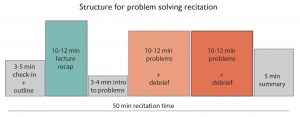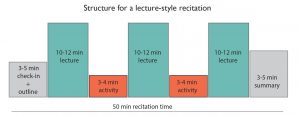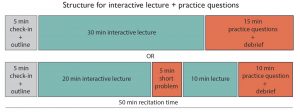At MIT Biology, recitations are meetings outside of lecture where the class TAs can work more closely with the students and facilitate meaningful learning. Preparing and teaching recitations are the primary responsibilities of a TA. This page details strategies used by undergraduate and graduate TAs who taught a variety of classes from large-lecture classes that are part of the Biology General Institute Requirement (GIR) to upper-level biology classes. Thanks to Phoebe Li (7.012), Vidit Bhandarkar (7.012), Joanna Lin (7.06) and Brian Vassilo (7.21/7.62) for sharing how they prepared for and structured their recitations.
Biology graduate students are required to participate in departmental TA training that emphasizes key aspects of teaching that are critical to the success of TAs. In addition to class-specific preparation, the sessions provide training in stereotype threat, implicit bias and enhancing student engagement.
Visit the TA Training Website
How do TAs prepare to lead recitation?
Depending on the class, your preparation for recitation will look slightly different. At its heart, preparing for recitation involves reviewing the past week’s lectures to identify material that you will discuss during recitation. The content in recitation can include reviewing topics covered in lecture, applying class material to new problems or contexts, and working on problem sets.

The materials that TAs should discuss during recitation differs between class. Phoebe and Vidit were TAs for the large lecture class 7.012 (Introduction to Biology), in which the instructor provided a handout containing a lecture summary and 2-3 problems. Below, they describe preparing to facilitate discussions regarding the lecture material.
Phoebe: I like to do a brief lecture recap at the start of recitation. I prepare slides beforehand if there is information that should be written out or included as an image. When there is a lot of material, I ask my students ahead of time which topics they would like me to cover. In case I decide to leave out some material, I prepare slides for the students to look over on their own time.
Vidit: My goal is to create an environment that encourages student participation such that the recitation is primarily student-led. I begin each recitation with slides about challenging concepts from lectures. These slides include thought-provoking, open-ended questions, as well as true/false questions and some images to explain ideas.
TAs for upper-level and smaller classes might not be given handouts to guide recitation. Instead, the TAs choose their own problems (for example, from a question bank) and decide on topics to discuss during recitation. Below, Brian describes the process for the class 7.21 (Microbial Physiology):
Brian: My preparation for recitation begins by going through the lecture slides from the past week and pulling out topics that are particularly important — often because the professors identified them as such during the lecture. I then write questions on those topics that are either comprehension- or application-based. My own answer key serves as a guide that I can use when discussing the students’ answers.
Structuring a recitation
Recitation time is limited and planning a structure in advance can help optimize effectiveness. Different strategies may be used to structure the time depending on your goals for the recitation. Recitation in large, undergraduate lecture classes is focused on problem-solving, while upper-level classes might include a reframed discussion of lecture material. In the sections that follow, former TAs describe the strategies they used for different types of classes. Each structure incorporates active learning techniques that enhance student engagement and learning.
What is active learning and why should TAs incorporate it?
Active learning occurs when students are actively engaged and are learning with their “minds on.” Almost any activity that requires students to recall, think about, apply, and verbalize concepts constitutes active learning. Preferably, activities are cooperative and include timely feedback. As students participate in such activities, they construct new knowledge and build new skills.
Read About Active Learning Techniques
There are several benefits to incorporating active learning techniques into your teaching practice. In contrast to a passive lecture, active learning techniques allow students to gauge their own understanding. By grappling with ideas, students connect new concepts to prior knowledge in meaningful ways and construct their own interpretations. Collaborating with classmates during recitation (for example, in a “pair-share” activity) promotes community and connection between students, which can enhance their sense of belonging and motivation. Depending on the class, there are different ways to structure recitation to incorporate active learning techniques, which are described in the following sections. In the video below, Janet Rankin, the director of the Teaching + Learning Lab (TLL) at MIT introduces active learning.
Watch Janet Rankin Introduce Active Learning
Large-lecture classes with a focus on problem solving
Recitation in large-lecture classes like Introductory Biology (7.01x) is typically a space for problem solving. This format lends itself well to “minds on” thinking. Instructors in large lecture classes typically provide TAs with a handout containing problems for each recitation. Having students work together in small groups creates a low bar to participation by encouraging every student to think and do. Interactive problem solving led by the TA is also a great way to keep students engaged for the duration of recitation. In the following section, Phoebe, Brian, and Vidit discuss how they structure their recitations to encourage problem solving.

Phoebe: For the first 10-15 minutes, I do a brief lecture recap framed for problem solving. For the problem solving in the second half, I find that students engage more with questions that require knowledge application. We tackle conceptual questions as a whole recitation by getting answers from volunteers. We then transition to application questions in small groups. At the end of each question set, I reiterate the most important concepts to orient the students for future questions.
Brian: At the beginning of recitation I make any necessary announcements and ask if the students have questions from the past week’s lecture. My goal is not to rehash lecture material, but to help work through any problem spots. I then distribute a worksheet and randomly break students into groups. I keep groups small (2-3 people maximum) to help students interact with many of their classmates over the semester, and ensure there is room within each group for everyone to contribute. We regroup after the first half of the worksheet has been completed to discuss solutions and any new questions the students have. We repeat the process with new groups working on the second half of the worksheet.
Vidit: I start each recitation with slides about concepts that seemed challenging from lectures. The introduction takes between 10-20 minutes, and is key to getting students warmed up and willing to participate. For the recitation handout, I read the questions out aloud and encourage students to answer various sub-parts one at a time. Thanks to the introductory slides, the students are usually eager to participate. For the most part, I end recitation 5-10 minutes early and stay to answer any questions.
Upper-level classes with lecture-style recitation
Recitations may be used to present key concepts from class a second time in an organized format, or as a discussion session. When you need to deliver a lot of information, consider breaking up lecture time into chunks of 10-15 minutes. Interspersing the lecture with short activities will keep your students engaged throughout. The same list of activities can be used to break up a lecture with 3-4 minute activities.

A hybrid approach: interactive lecture and practice questions
For upper-level classes, an alternative to lecture-style recitation requires incorporating a short problem that complements the lecture material. Joanna used this hybrid strategy for 7.06 (Cell Biology) recitations.
Joanna: I make 5-6 skeletal slides that cover the main topics from class; I aim to use 30 minutes of recitation time on them. To keep the lecture section interactive, I fill out some the slides myself and have the students participate to fill in others. We spend the remaining 15 minutes of recitation on practice questions. Below are two timelines I use.

Encouraging student participation
Student engagement and participation are crucial to a successful recitation session. Class participation increases when the students feel comfortable and safe in the classroom. The following strategies to engage students are adapted from the book “Tools for Teaching” by Barbara Gross Davis.
- Allow the class time to warm up: Arrive a few minutes early and talk informally with your students. If a student asked a relevant question via email or after class, bring the question into the classroom and give credit to the student.
- Periodically divide students into small groups: Students may find it easier to speak to groups of three or four. Divide them into small groups to discuss a question or problem for 5-10 minutes, and then reconvene the class.
- Draw all your students in: Ask everyone to jot down a response to a question, pause, and then ask a student to share what they wrote down. Try to discourage students who might monopolize the discussion or volunteer answers to every question.
- Limit comments: Students frequently develop their ideas further by responding to one another. Leave room for this to happen by limiting your own comments.
- Limit comments: Avoid the temptation to respond to every student’s contribution. Instead, allow students to develop their ideas and respond to one another.
Vidit: I often chatted with students before recitation began. I make sure to refer to them by their names and keep my tone casual and conversational. I established early on that there are no real wrong answers — this helped increase participation further. If a student got something wrong while volunteering an answer, I avoided giving away the answer immediately. I prompted them and ask follow-up questions to help them arrive at the answer themselves.
Brian: When discussing answers to the worksheet questions as a larger group, I ask a group that hasn’t participated yet to answer. After the students have answered some questions, they may remember or encounter a new question on the material that’s separate from the worksheet. I make sure to ask if the students have questions between problems to catch these questions.
FAQs for Biology TAs
How do I balance working in a lab with my TA responsibilities?
Responding to student email, dealing with class logistics, and grading can take a lot more time than expected. Set up boundaries and expectations early on — this is essential to protect your time as a TA.
- Email: Set up time windows when you will respond to student emails. During your first recitation, let your students know what these time windows are. Depending on the volume of emails and class-size, Piazza might be a better forum for student questions.
- Class Logistics: Discuss your responsibilities with the class instructor before the semester begins to help you plan your time in the lab.
- Grading: Use the answer key and first few student submissions to generate a rubric before you begin grading. This will help you grade more consistently without going back and forth. Consider using the online grading software Gradescope, which has a dynamic rubric and makes grading faster.
What should I do if I don’t know the answer to a student’s question?
Saying “I don’t know, but I’ll look into it” to a student’s question is completely fine. Another option is to admit you are not sure, and provide guidance on how to find the answer. You can look up the answers to any questions while your students are working in groups during recitation, or get back to them via email after class. If a question is worth clarifying with the whole class, consider spending a couple minutes in the next recitation going over both the question and answer.
What “level” should I teach at?
In any class, students will feel different levels of comfort and familiarity with the material. As their TA, your aim should be to present the base knowledge that a student needs to succeed in the class. Encourage the students who may be struggling to see you in office hours, and inquire whether they might benefit from getting a tutor. Engage your advanced students by letting them know they can meet you during office hours as well, and provide further reading on the material they are interested in.
Are there any recommended software for remote TAs?
Training on select MIT-licensed remote teaching software is accessible to the MIT community at the Biology TA training Canvas site. The following software are recommended for running recitation remotely:
- Zoom for recitation meetings with the breakout room feature to form smaller groups.
- Explain everything to create a digital whiteboard.
- Gradescope for remote grading.
How do I know how I’m doing as a TA?
Ask for feedback from your students and co-TAs. This can be as simple as asking students to write down one thing that went well and one thing they are confused about as they leave recitation. You may also consider having an outside observer give you feedback on your teaching. Consult with the Biology TA training team to book an observation session.
Continued training opportunities
MIT’s Teaching + Learning Lab (TLL) offers several additional training opportunities for graduate students. For first-time TAs, TA Days are a series of workshops that provide resources and training on navigating TA responsibilities.
The TLL also offers two teaching certificate pathways that provide training in evidence-based teaching techniques:
Biology graduate students can also apply to be a departmental Teaching Development Fellow. Fellows organize department-based events and develop resources to support Biology TAs.




